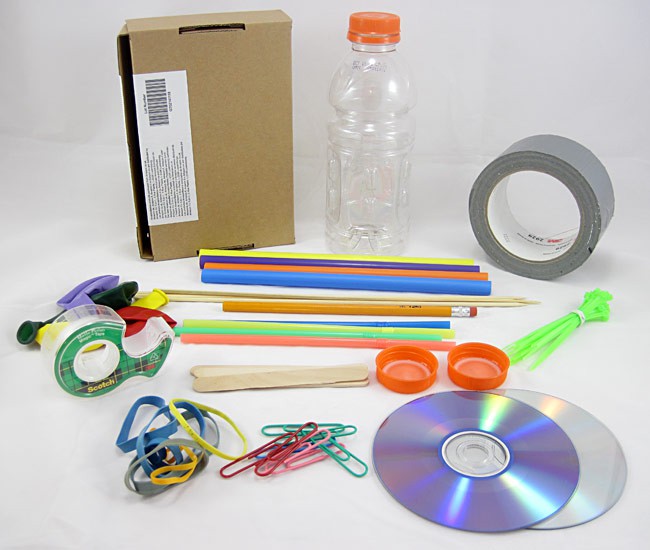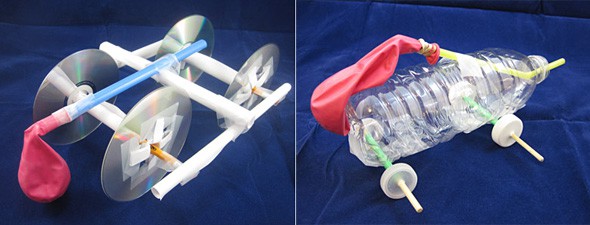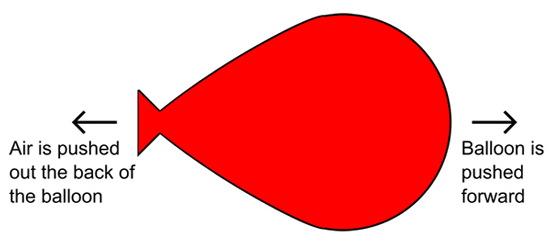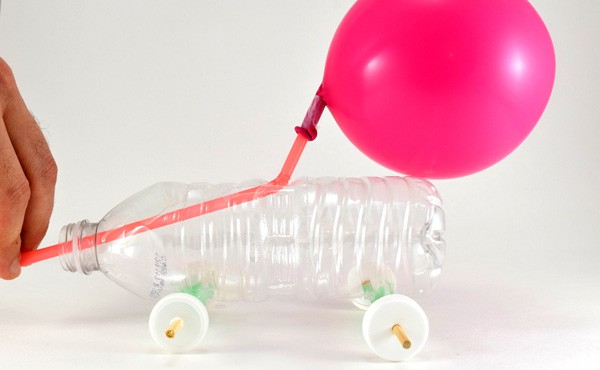Summary
This engineering challenge is based on an internal competition designed by employees at Fluor Corporation.
Overview
Your students will design, build, and race balloon-powered cars in this fun lesson plan that teaches about engineering design and kinetic and potential energy.Learning Objectives
- Understand what potential and kinetic energy are and how one can be converted to the other.
- Use the engineering design process to iteratively test and modify a design.
NGSS Alignment
This lesson helps students prepare for these Next Generation Science Standards Performance Expectations:- MS-PS3-5. Construct, use, and present arguments to support the claim that when the kinetic energy of an object changes, energy is transferred to or from that object.
- MS-ETS1-4. Develop a model to generate data for iterative testing and modification of a proposed object, tool, or process such that an optimal design can be achieved.
|
Science & Engineering Practices
Constructing Explanations and Designing Solutions. Apply scientific ideas or principles to design, construct, and test a design of an object, tool, process, or system.
Engaging in Argument from Evidence. Evaluate competing design solutions based on jointly developed and agreed-upon design criteria. |
Disciplinary Core Ideas
PS3.A: Definitions of Energy.
Motion energy is properly called kinetic energy; it is proportional to the mass of the moving object and grows with the square of its speed.
A system of objects may also contain stored (potential) energy, depending on their relative positions. PS3.B: Conservation of Energy and Energy Transfer. When the motion energy of an object changes, there is inevitably some other change in energy at the same time. ETS1.B: Developing Possible Solutions. A solution needs to be tested, and then modified on the basis of the test results in order to improve it. |
Crosscutting Concepts
Energy and Matter.
Energy may take different forms (e.g. energy in fields, thermal energy, energy of motion)
The transfer of energy can be tracked as energy flows through a designed or natural system. |
Materials
 Image Credit: Ben Finio, Science Buddies / Science Buddies
Image Credit: Ben Finio, Science Buddies / Science Buddies
Note: since this is an engineering design project, it does not have an exact list of required materials for students to build their cars. You can use the materials you have available in your classroom, including recycled materials, to keep costs down. The list below provides some suggestions.
- Open floor space
- Tape measure
- Wheels (round objects like CDs and bottle caps, etc.)
- Axles (wooden skewers, pencils, straws, etc.)
- Frame/body (plastic bottles, cardboard boxes, popsicle sticks, etc.)
- Straws
- Balloons
- Rubber bands
- Tape
- Scissors
- Other assorted classroom/office supplies (paper clips, binder clips, zip ties, etc.)
Background Information for Teachers
This section contains a quick review for teachers of the science and concepts covered in this lesson.In this project, your students will design and build balloon-powered cars. The cars are propelled forward by air escaping from a balloon, and can be built using a variety of different materials as shown in Figure 1.
 Image Credit: Science Buddies
Image Credit: Science Buddies
Figure 1. Examples of two balloon-powered cars built with different materials.
Regardless of the materials used to build them, the basic operating principle of the cars is the same. When you inflate a balloon, it stores potential energy in the stretched rubber of the balloon and the compressed air inside it. When you release the balloon, air escapes out the nozzle, pushing the balloon forward (Figure 2). The stored potential energy is converted to kinetic energy, the energy of motion, as the balloon is propelled forward. According to conservation of energy, the amount of stored potential energy equals the resulting amount of kinetic energy. Eventually, the kinetic energy is converted to thermal energy (or heat) as friction slows the balloon down. The air escaping the balloon also demonstrates Newton's third law of motion: for every reaction there is an equal and opposite reaction.
 Image Credit: Ben Finio, Science Buddies / Science Buddies
Image Credit: Ben Finio, Science Buddies / Science Buddies
Figure 2. Newton's third law of motion for an inflated balloon.
When you inflate a balloon and release it, it will tend to wobble and zoom randomly around the room. You can attach the neck of a balloon to a straw by wrapping a rubber band or tape around it several times, as shown in Figure 3. When you connect the straw to the body of a car, this allows you to aim the direction of the escaping air, so you can make sure it pushes the car forward. The car will initially accelerate as the balloon deflates, and eventually it will come to a stop as the balloon runs out of air and friction slows the car down.
 Image Credit: Ben Finio, Science Buddies / Science Buddies
Image Credit: Ben Finio, Science Buddies / Science Buddies
Figure 3. Balloon attached to straw with rubber band.
In this lesson, your students will follow the engineering design process. You will help them get started by showing them how to connect a balloon to a straw as shown in Figure 3, but then they will select their own materials to design and build the body, wheels, and axles of their cars. The engineering design process is an iterative process where students design, build, and test their cars. It is important for students to understand that there is no single "right answer" to an engineering project. There are multiple possible solutions to the problem, and it is OK if their cars do not work very well on the first try. Part of the process is redesigning, rebuilding, and retesting your container based on what you learn from your initial tests.






